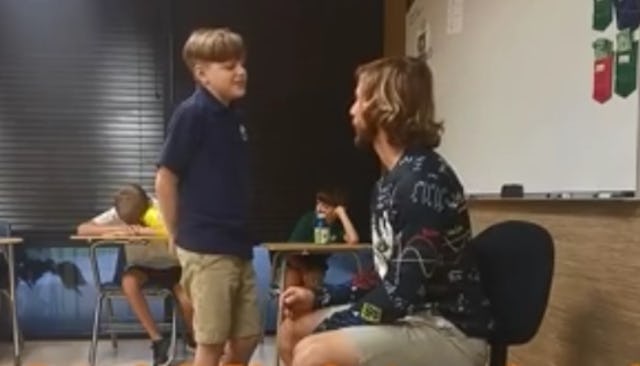Teacher's Daily Affirmations To Special Needs Students: 'I Love Having You In My Class'

A video highlighting the methods a Florida special needs teacher employs in his classroom has gone viral. In the clip, we see him spend time complimenting each of his students and when you hear how it’s helping them, you’ll see what a huge impact a teacher can have on a child.
Chris Ulmer has taught the same group of special needs students for the last three years and in his words, they’re like a family now. From A Plus, Ulmer explains that each morning, he takes 10 minutes to compliment his students individually and that it’s yielded an incredible result. He uploaded a video of their daily ritual to his page, Special Books by Special Kids. It now has over 1.7 million views.
Ulmer spends those few minutes heaping praise on his students, reminding them of all the reasons they’re valuable to his class. You can see the delight on their faces and really, who could blame them? Here are a few of the wonderful compliments Ulmer gives his kids:
You sir, are an amazing student. You’re very funny, you’re very smart, you do a great job everyday and you make everyone laugh because you’re so silly.
I love having you in my class. I think you’re very funny. I think you’re amazing. I think you are brilliant. I think everyone in here loves you.
You are a great student. I love having you in my class. You’re funny. You’re athletic. You’re a great soccer player. You’re very smart. You’ve been doing a great job reading. You’re been reading grade-equivalent words, which means you’re very smart.
The video includes quotes from Ulmer in subtitles explaining his philosophy. “I have seen their confidence and self-worth sky rocket. Instead of focusing on deficits, I focus on talents,” noting that “a child’s reality is shaped from early life experience.” It’s easy to see how their confidence would improve — hearing those affirmations daily has to have a significant impact on how they see themselves.
Ulmer is clearly doing something fantastic for these kids, but there’s even research to back it up. Purdue University’s Human Development Extension Program gives an excellent reason for providing positive reinforcement in large doses. “Children learn about themselves when you interact with them. You can help them learn good things about themselves or bad things.” Ulmer’s experience with his students proves this to be true. He says, “After a few weeks of this practice, my students started complimenting one another consistently. They praise each other for accomplishments as if it was their own. They never insult one another and actively work towards helping each other.”
The Purdue program also emphasizes that being positive with kids starts a cycle of repeating good behavior by providing a child with attention for something other than misbehavior. “Positive reinforcement also gives children attention. Children love and need attention. They can get attention by doing good things and by doing bad things. You can avoid some bad behaviors by giving the child attention at the right times. Give your child plenty of positive attention so that he won’t need to misbehave to be noticed by you.” By giving his students compliments from the start, Ulmer is kicking things off on the right note. He shows them love and acceptance, shaping the tone of the entire day in a positive way.
As Ulmer says at the close of the video, “Hate is a learned behavior. Love is natural.” Children innately want to love and be loved, and will give back what they get. By showing them positive attention early and often, this teacher is helping his students feel good about themselves which is translating to them treating each other better. That can only fuel the learning process and make them more productive students. And better human beings. Hopefully, other teachers will see his methods in action and take on some of these behaviors in their own classroom. All children, regardless of need, can benefit from the kind of affirmations this teacher gives his students.
This article was originally published on